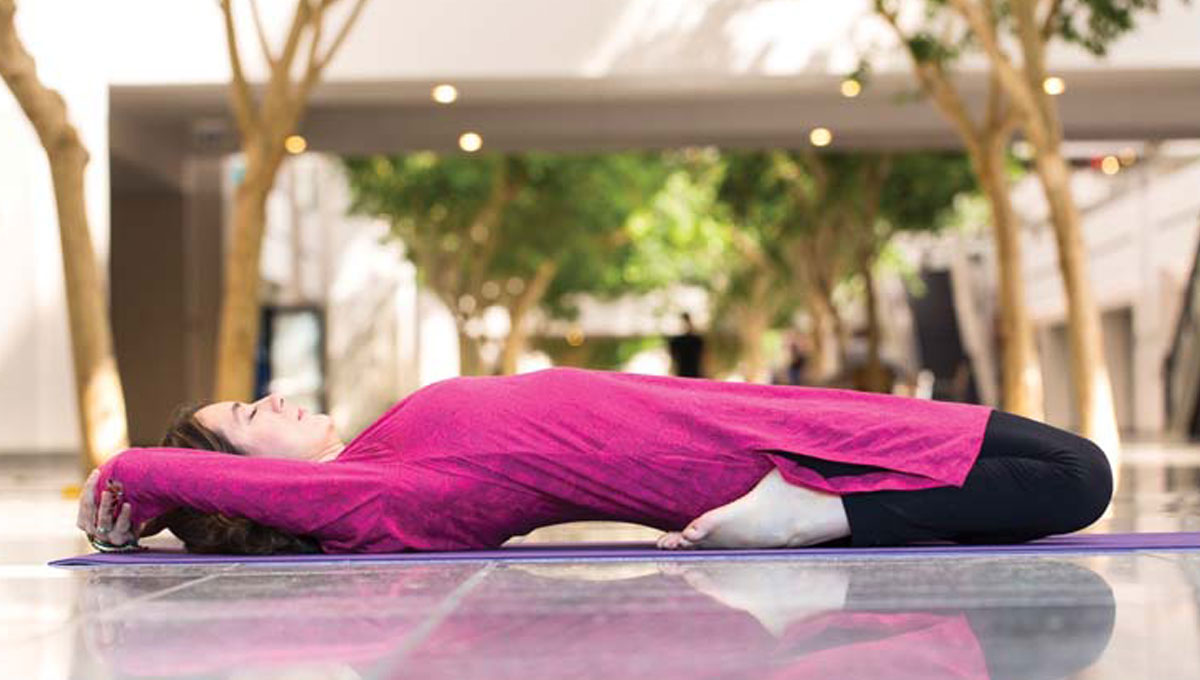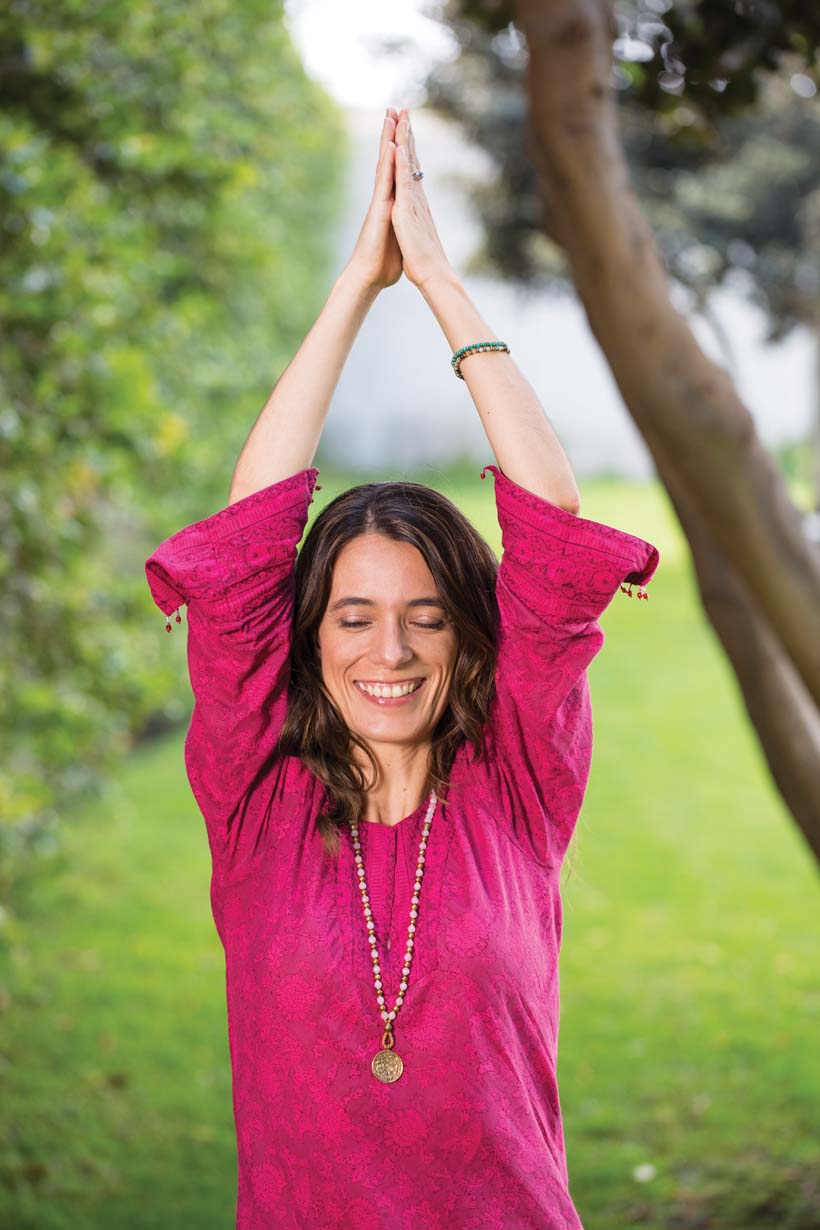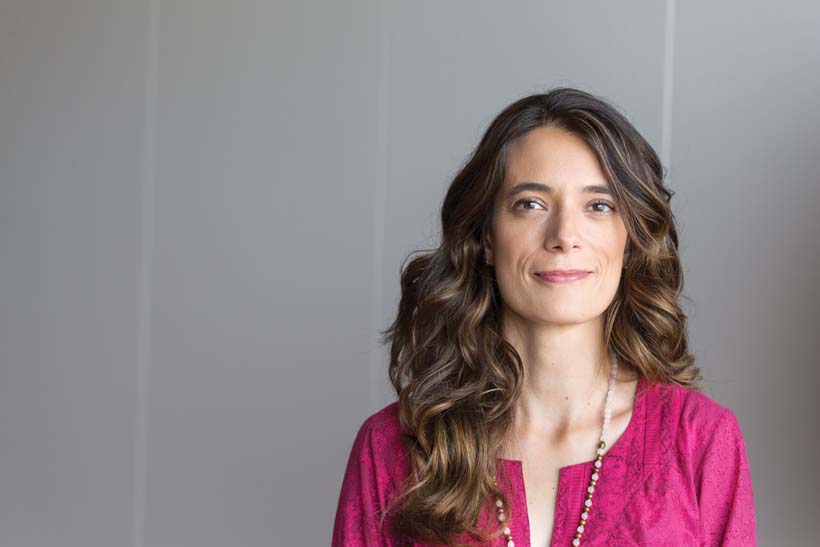
Ana Funes photographed by David Young-Wolff
“Don’t just accept everything that the Yoga Sutra tells you,” Ana Funes says to her students.
Dr Ana Funes Maderey teaches in the Master of Arts in Yoga Studies program at Loyola Marymount University; her students are enthusiastic yogis and yoginis (female yogis) pursuing the academic study of yoga in all its facets.
A dedicated scholar, Ana believes in the importance of reading the scriptures and then exploring and questioning those very same sacred texts.
Ana grew up in an academic environment; both her parents were geography professors at National Autonomous University of Mexico (UNAM) in Mexico City, the largest institution of higher learning in Latin America. “People think that having geographers as parents meant you would grow up traveling the world,” she says. They did travel, though, throughout Mexico’s beaches and villages that were a contrast to their metropolitan life.
When she turned 18, Ana began collecting stamps in her passport. She studied English in Canada. She backpacked through Europe, and has been to India four times. Ana did her doctoral studies in Hawaii before landing a job at Loyola Marymount University in 2014.
Yet the most significant travels of Ana’s life have not been across continents but into the realm of consciousness, travels that began while she was still living in Mexico City.
At the age of 14, the young philosopher experienced her first meditation class with her mother. Then she was in her early twenties when she discovered the physical practice of yoga. After her first Iyengar class Ana was sure that, “This is not for me!” She believed the class was too difficult for her stiff body. When a friend invited her to a Kundalini class, Ana found a sense of freedom and a better understanding of the layers of the body—an understanding that would ultimately drive her continued asana practice as well as her academic study. “It was through Kundalini Yoga that I realized it was not important to be flexible to practice yoga.”
Ana was able to take this approach back to a physical practice of yoga—including a return to and love for the Iyengar style since Ana discovered she was able to approach the alignment of the pose from the perspective of the inner awareness of the body in asana.
This experience initiated an immersion into yoga where she enjoyed the practice. “I remember the first time that I touched my toes. It was one of those moments when you sort of forget that you were not used to touching your toes, and then all of a sudden it happened.” There was a sense of accomplishment. There was an empowerment found in even the simplest external aspects of the practice. There is a fine line to this empowerment. Ana carefully describes the tricky balance between this realization of the deeper sense of self with the tension of the ego always wanting more. She refers to this as a “bit of yogic greed.” Cultivating awareness is the antidote to this very common trap.
Ana completed the first year of the rigorous Iyengar teacher training program before the demands of an academic life sidelined her, although it is still something she hopes to complete. She has taken other teacher trainings—during a six month trip to India in 2007, Ana finished the 200 hour program with Sivananda Yoga. She also completed a two year teacher training in Universal Yoga—a popular style in Latin America. In addition, Ana is a Kundalini Yoga instructor, which was the first yoga teaching certification she earned in Mexico City in 2004.
When asked about her personal practice today, Ana says, “There is one pose that I do every day. I recline over a bolster, in a backbend, and breathe.” This restorative asana helps her to decompress after teaching and was especially important during the rigor of completing and defending her PhD thesis in Spring 2016. Befitting someone whose field of study focuses on proprioception and the internal experience of the body as seen in yogic philosophy, she describes the rest of her personal practice as eclectic, drawing on her years of study in various lineages. “I do what my body needs.”

Ana Funes photographed by David Young-Wolff. Jewelry by Love Pray Jewelry
Ana explains her lifelong pursuit of this yogic field of study, “I wanted to understand what kind of philosophy of mind and body was behind a yoga practice.” Speaking about how philosophy addresses the body and mind, Ana describes the prevailing view of the body in Western philosophy as being reductionistic, too small and too limited. Ana pursued a formal study critiquing the notion of how we understand the body through Western and Eastern philosophical traditions. She earned both her Bachelor’s and Master’s degrees in Philosophy of Religion and Hermeneutics at the National Autonomous University of Mexico where her thesis work focused on the Indian philosophies of Advaita Vedanta and the Yoga Sutra.
Because she knew that she wanted to continue the depth of study required to earn a doctorate degree, Ana moved to the University of Hawaii to work on her PhD in Comparative Philosophy under the guidance of Professor Arindam Chakrabarti. Her thesis topic is proprioception and bodily self-awareness related to the notion of the subtle body as it is found in Samkhya Yoga, Vedanta, and Kashmir Shaivism using phenomenological methodology.
Her aim was to make sense of the discussion in the yogic texts of the concepts of the subtle body, the causal body, and how the mind can be a body and how the body can be a mind. Through meditation and yoga, as well as the yogic texts and Indian philosophy, Ana has become aware of a more nuanced view of the integration of the body and the mind—that the mind is also the body.
Ana brings both her curiosity and enthusiasm for critical thought to all of the classes she teaches at Loyola Marymount University’s innovative Master of Arts Degree in Yoga Studies. Some of the varied courses the Assistant Clinical Professor teaches include Hatha Yoga Texts and Sanskrit—The Bhagavad Gita. Through the study of the texts, as well as discussion of both historical and modern contexts in philosophy, Ana wants to ensure students understand how diverse the yoga tradition actually is. Yoga is not a monolithic linear tradition but rather a long tradition of many yogas.
It is important to her to encourage students to question the assumptions they may have about the history of yoga as well as the challenges of applying the practice in the face of modernization and commercialization. This is where Ana promotes critical thinking: “Don’t just accept everything that the Yoga Sutra tells you.”
She explains that while the Yoga Sutra is an important text, it is a text with a particular point of view. According to Ana, the study of yoga’s ancient scripture is essential to becoming a well-rounded yogi or yogini, but there is a value to applying critical thinking and analysis to even ancient venerated texts. The Vedas, Upanishads, Bhagavad Gita, and Yoga Sutra all contain verses that could be considered controversial in today’s era of examining issues of race, gender, and ecology. In some instances these texts seem to advocate a caste system, appear to be derogatory against women, and even include animal sacrifice. However, just because a text contains material that is not relevant to current society doesn’t mean we dismiss that text completely. When it comes to discovery of yoga’s history and discovery of ourselves, it is important for us to see more than our idealization of the philosophy and the practice.
We discover the nuances of the layers of the body through study and practice. Similarly, the ability to understand the mind in the body and the body in the mind develops through our sincere practice, deep philosophical and textual study, and our travel through layers of consciousness. For Ana, every conversation is a journey through language and philosophy, the questioning of the thinking body, and considerations of how we perceive ourselves. Clearly, she is passionate about her own journey of understanding and of finding strength and depth in what is and isn’t in the texts. What’s her conclusion to the answer of the conundrum of the mind and the body and the body in the mind?
“The body itself is consciousness.”

Ana Funes photographed by David Young-Wolff. Jewelry by Love Pray Jewelry. Hair and Makeup by JJ Jeffries
Ana Funes teaches in the Yoga Studies program at Loyola Marymount University.
Jewelry by Love Pray Jewelry: loveprayjewelry.com
Hair and Makeup by JJ Jeffries using Schwarzkopf professional products: couturebeautyteam.com
Yoga Mat by Jade Yoga: jadeyoga.com
